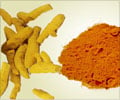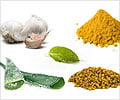Lead-tainted turmeric poses hidden health risks, impacting wellness with toxic exposure. Learn about the dangers and stay safe with mindful spice choices.

Evidence of turmeric adulteration with lead chromate across South Asia
Go to source). The study, published in the journal Science of The Total Environment, found that turmeric sold in India’s Patna; Pakistan’s Karachi and Peshawar; and Nepal had lead levels in turmeric exceeding 1,000 micrograms/gram. This is about 200 times more than the limit set by the Food Safety and Standards Authority of India (FSSAI) -- 10 micrograms/gram.
‘#Lead in #turmeric can harm your health, especially in children? Learn more about the dangers of lead exposure. #leadpoisoning #cognitivedevelopment’





Researchers led by the University of Stanford in the US, along with those from India, found that turmeric sold in Guwahati and Chennai also exceeded the regulatory limit. The Hidden Threat in Turmeric
“Turmeric, widely recognized for its anti-inflammatory and antioxidant properties, is often consumed in significant quantities, making lead contamination especially dangerous. Lead exposure through contaminated turmeric can cause gastrointestinal toxicity, manifesting as abdominal pain, nausea, vomiting, and constipation,” Dr. Mahesh Gupta, Senior Consultant - Medical Gastroenterology, Dharamshila Narayana Hospital, told IANS.“This study serves as a reminder to approach traditional remedies with caution, as overdose or consumption of contaminated turmeric could worsen health rather than improve it,” he added. The study showed that the most likely source of lead in turmeric samples was lead chromate -- a yellow pigment used in paints, rubber, plastics, and ceramic coatings. Polished roots and loose powder were the only forms of turmeric with lead levels above 1,000 micrograms/gram.
“Children can have learning disabilities, including low IQs, and long-term exposure in adults can increase the risk of heart disease and strokes, and can also lead to certain different neurological disorders,” Dr Manisha Arora, Director - Internal Medicine at the CK Birla Hospital (R), Delhi, told IANS.
Gupta said regular intake can also impact liver function, impair the organ’s ability to detoxify the body, and lead to oxidative stress in the gastrointestinal lining, which can aggravate inflammatory conditions like gastritis, peptic ulcers, and even irritable bowel syndrome (IBS).Given that loose, unregulated turmeric often exceeds safe lead levels, consumers with digestive sensitivities should be especially cautious, opting for packaged and branded turmeric products that meet regulatory standards, the experts noted.
Advertisement
Reference:
- Evidence of turmeric adulteration with lead chromate across South Asia - (https://www.sciencedirect.com/science/article/pii/S0048969724051532)
Source-IANS















